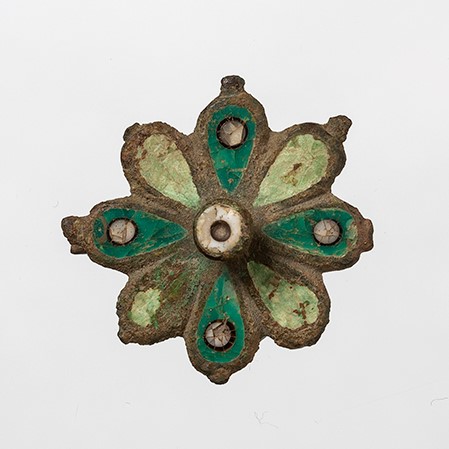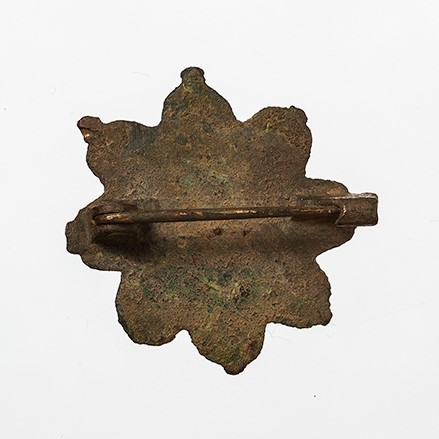Acquisition number: 1977.04
Bronze brooch in the form of a flower of eight petals. The petals have glass inset in the bronze and are alternately light and dark green; the dark green has small circular white inserts outlined in black. There is a high central ‘pistil’ inset with black and white. Some of the bronze tips to the petals are missing and the inlay is somewhat worn, especially the light green. The pin and clasp at the back have been repaired.
Title: Enamelled Bronze Brooch - 1977.04
Acquisition number: 1977.04
Author or editor: J.R. Green
Culture or period: Roman Imperial
Date: Second half 2nd century AD.
Material: Metal - Bronze
Object type: Jewellery
Dimensions: 34mm (l) × 34mm (w)
Origin region or location: Germany
Display case or on loan: 9
Keywords: Roman, Imperial, Celtic, Germany
Charles Ede Ltd (London), Catalogue 108 (November 1977) no. 19 (ill.); J.R. Green with B. Rawson, Catalogue of Antiquities in the Australian National University, A.N.U. (Canberra, 1981) 105.
1977.04
Enamelled Bronze Brooch
Purchased. Diam. 3.4cm.
Bronze brooch in the form of a flower of eight petals. The petals have glass inset in the bronze and are alternately light and dark green; the dark green has small circular white inserts outlined in black. There is a high central ‘pistil’ inset with black and white. Some of the bronze tips to the petals are missing and the inlay is somewhat worn, especially the light green. The pin and clasp at the back have been repaired.
Brooches of this type were manufactured in the north-west provinces of the Roman Empire, especially Germany, and they show Celtic influence in design and technique. They belong principally to the second half of the second century AD, although they continued to be made somewhat later.
A good series of examples from the Rhineland is illustrated in Antiken aus Rheinischem Privatbesitz (Bonn 1973) no. 420/1-13, pll. 189-191. See also the basic classification of the types by K. Exner, “Die provinzialrömischen Emeilfibeln der Rheinlande”, Bericht der römisch-germanischen Kommission des Deutschen Archäologischen Instituts 29, 1939, 31-121, and then S. Thomas, “Die provinzialrömischen Scheibenfibeln der römischen Kaiserzeit im freien Germanien”, Berliner Jahrbuch für Vor- und Frühgeschichte 6, 1966, 119-178. Brooches of this general type also appear in Britain: See for example B. Paites, “The Manufacture and Symbolism of Radiating Designs on Brooches in Roman Britain”, Lucerna 50, 2016, 14-21; J.D. Bateson, Enamel-Working in Iron Age, Roman and sub-Roman Britain. The Products and Techniques (Oxford 1981).
There are good notes on the technique of Roman enamelling by S.A. Butcher in D. Strong and D. Brown (eds), Roman Crafts (London 1976) 43-51. See also now J. Bayley, “Roman Enamels and Enamelling”, in: J. Bayley, I. Freestone and C. Jackson (eds), Glass of the Roman World (Oxford 2015) 178-189.
Charles Ede Ltd (London), Catalogue 108 (November 1977) no. 19 (ill.); J.R. Green with B. Rawson, Catalogue of Antiquities in the Australian National University, A.N.U. (Canberra, 1981) 105.

